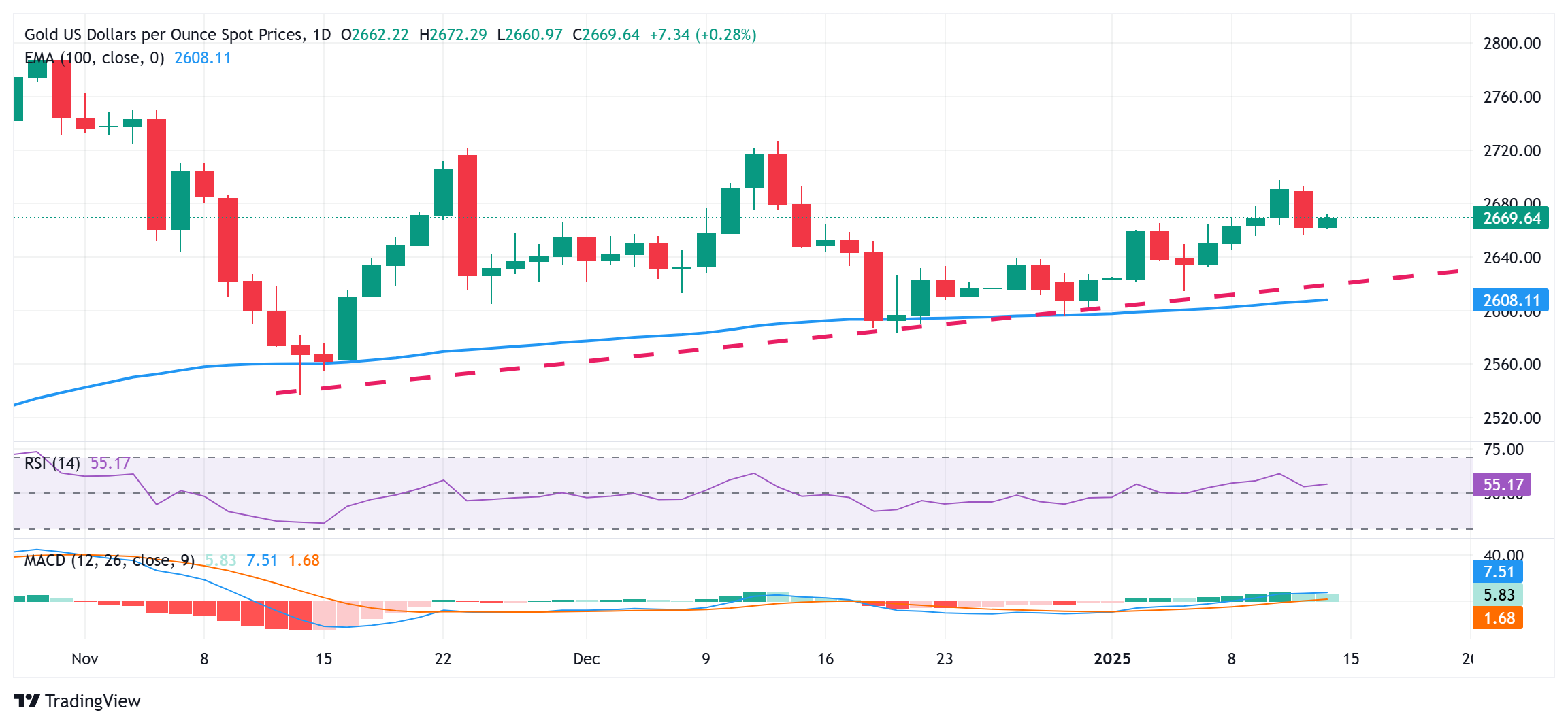Gold price trades with positive bias amid retreating US bond yields
- Gold price regains positive traction amid a modest pullback in the US bond yields.
- Hawkish Fed expectations favor the USD bulls and should cap the precious metal.
- The risk-on impulse might further contribute to keeping a lid on the XAU/USD pair.
Gold price (XAU/USD) attracts some dip-buyers during the Asian session on Tuesday and reverses a part of the previous day's retracement slide from the vicinity of a one-month top touched last week. Reports that US President-elect Donald Trump's top economic advisers are mulling a slow ramp-up in tariffs to prevent a sudden spike in inflation trigger a modest pullback in the US Treasury bond yields and benefit the non-yielding yellow metal. Apart from this, the uptick lacks any obvious catalyst and is likely to remain capped amid hawkish Federal Reserve (Fed) expectations.
The upbeat US Nonfarm Payrolls (NFP) report released on Friday reinforced bets for a slower pace of interest rate cuts by the US central bank this year. This, in turn, assists the US Dollar (USD) to stall its profit-taking slide from over a two-year peak touched on Monday and should act as a tailwind for the US bond yields. Meanwhile, easing fears about disruptive trade tariffs under Trump 2.0 boost investors' confidence, which further warrants some caution before placing fresh bullish bets around the Gold price. Traders now look to the US Producer Price Index (PPI) for a fresh impetus.
Gold price draws support from retreating US bond yields; upside seems limited amid hawkish Fed expectations
- Bloomberg, citing people familiar with the matter, reported on Monday that President-elect Donald Trump's economic advisers are considering a program to gradually increase tariffs month by month.
- The approach, aimed at boosting negotiating leverage and helping avoid a sudden spike in inflation, triggers a modest pullback in the US Treasury bond yields and revives demand for the Gold price.
- The sizzling US job report cemented expectations the Federal Reserve will proceed with caution while cutting rates this year, which helps the US Dollar to stall Monday's pullback from over a two-year high.
- The Fed's hawkish outlook should also limit the benchmark 10-year US Treasury bond yields' corrective slide from a 14-month high and keep a lid on any further gains for the non-yielding yellow metal.
- US President-elect Donald Trump has repeatedly promised to end the conflict in Ukraine and said that he will meet Russian President Vladimir Putin “very quickly” after he takes office next week.
- The US indicated that a ceasefire deal is on the brink of success while Hamas said talks are progressing well. Two Israeli officials said that Hamas will release 33 hostages in the first phase of the ceasefire agreement.
- Investors now look forward to key inflation prints – starting with the Producer Price Index later today, followed by the US consumer inflation figures on Wednesday – for some meaningful impetus.
Gold price bulls have the upper hand while above the 100-day EMA and trend line confluence support, near $2,610

From a technical perspective, any subsequent strength beyond the $2,676-2,677 area is likely to confront some resistance near the $2,690 zone ahead of the $2,700 mark. Some follow-through buying beyond the latter will set the stage for an extension of over a three-week-old uptrend and lift the Gold price to the $2,716-2,717 hurdle en route to the December monthly swing high, around the $2,726 region.
On the flip side, the $2,657-2,656 area, Monday's low, might continue to protect the immediate downside. A convincing break below, however, could make the Gold price vulnerable to accelerate the downfall towards the $2,635 region. The downward trajectory could extend further towards the $2,610 confluence, comprising the 100-day Exponential Moving Average (SMA) and a multi-week-old ascending trend line.
Gold FAQs
Gold has played a key role in human’s history as it has been widely used as a store of value and medium of exchange. Currently, apart from its shine and usage for jewelry, the precious metal is widely seen as a safe-haven asset, meaning that it is considered a good investment during turbulent times. Gold is also widely seen as a hedge against inflation and against depreciating currencies as it doesn’t rely on any specific issuer or government.
Central banks are the biggest Gold holders. In their aim to support their currencies in turbulent times, central banks tend to diversify their reserves and buy Gold to improve the perceived strength of the economy and the currency. High Gold reserves can be a source of trust for a country’s solvency. Central banks added 1,136 tonnes of Gold worth around $70 billion to their reserves in 2022, according to data from the World Gold Council. This is the highest yearly purchase since records began. Central banks from emerging economies such as China, India and Turkey are quickly increasing their Gold reserves.
Gold has an inverse correlation with the US Dollar and US Treasuries, which are both major reserve and safe-haven assets. When the Dollar depreciates, Gold tends to rise, enabling investors and central banks to diversify their assets in turbulent times. Gold is also inversely correlated with risk assets. A rally in the stock market tends to weaken Gold price, while sell-offs in riskier markets tend to favor the precious metal.
The price can move due to a wide range of factors. Geopolitical instability or fears of a deep recession can quickly make Gold price escalate due to its safe-haven status. As a yield-less asset, Gold tends to rise with lower interest rates, while higher cost of money usually weighs down on the yellow metal. Still, most moves depend on how the US Dollar (USD) behaves as the asset is priced in dollars (XAU/USD). A strong Dollar tends to keep the price of Gold controlled, whereas a weaker Dollar is likely to push Gold prices up.
